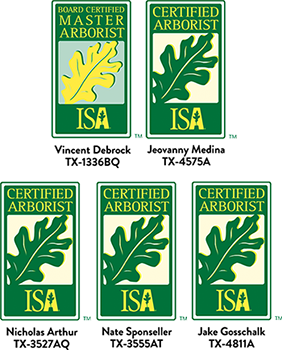Soil compaction is the #1 cause of death to residential trees. A lot of that damage happens during construction as equipment and traffic injure delicate feeder roots in the top few inches of soil.
All trees can be damaged during construction, but in Central Texas,we have a lot of Post Oaks that are very intolerant of soil disruption. They become stressed, and within a few years, they can be dead while your contractor is long gone. The time to protect your trees is before you build your new house or begin your home improvement project.
You know your trees add to property value, provide shade and beauty, and improve the environment: you don’t want to kill them. A mature oak tree can be over 100 years old and can’t be replaced in our lifetime.
Five Ways Trees Can Be Damaged During Construction

Tree suffocated by soil compaction during home construction, resulting in loss of too many roots. Tree is now dead.
1. Soil compaction is the hidden killer.
Roots, roots, roots; trees must have lots of healthy ones. The ideal soil for trees has 50 percent pore space filled with air and water. Heavy equipment, traffic, and stacks of building materials pack the soil. Remember, 90% of a tree’s feeder roots grow in the top few inches of soil.
2. Damage to the trunk or limbs from equipment
Every injury to a tree is permanent. Even minor injuries can allow fungi to enter the tree and decay to damage the tree.
3. Cutting roots while digging or trenching
Anchor roots can extend a distance of one to three times the height of the tree. Severing even one major root can remove 15 to 25 percent of its root system and make it more likely that the tree will fall.
4. Removing nearby trees or shrubs
Neighboring trees give protection from the wind and the sun. Removing some of them exposes the others to new conditions that may stress them. An arborist can evaluate which trees will be most likely to survive this transition.
5. Smother roots by changing the soil grade
Placing even a few inches on top of the root zone can deprive the crucial feeder roots of air and water. Removing the soil changes drainage patterns and can expose or drown the roots.
Pre-construction Planning Can Save Your Trees

Construction material staged over root zones, resulting in compacted soil.
Call a Certified Arborist while your project is still in the planning stage.
We can assess the trees you have and determine which ones are healthy and worth saving. You don’t want to plan around those that are not suitable for your property plans. Furthermore, trees that are unsound or not likely to survive the construction process can become a liability.
An arborist can meet with your architect or contractor and help them choose the best practices to protect trees. It is often possible to re-route trenching to avoid root damage or use special techniques to avoid cutting them. He or she can make recommendations for care that will help ensure their survival.
You will save time and frustration if you include a tree consultation in the early phases of the project.
Prepare a Tree Preservation Plan
Remember: as the property owner it’s your responsibility to protect your trees. If you are not in a municipality that requires a Best Management Plan for tree care before you get a building permit, it still needs to be done.
Either hire a Certified Arborist to establish the plan and mark the Tree Protection Zones or do it yourself- but be sure your builder knows you want to include tree preservation in the planning process.
The site map shows all the trees which you have decided to keep. Of course, you will include the location of buildings, driveways, and the routes for utility trenching. Put all your plans in writing and make sure all responsible parties get a copy.

Soil damage hidden by a thin layer of “red death” chocolate loam soil. Evidence of damage on tree trunks. These trees and the future landscaping will have a hard time making it in this damaged soil.
The Critical Tree Protection Zone is the Most Important Focus
As a general rule, the Tree Protection Zone (TPZ) should be 1 foot for each inch of diameter of the tree at the height of four feet from the ground. You may need to expand this for older trees and those with moderate or poor tolerance for soil disturbance.
Erect a temporary fence around this area to protect the roots from traffic, which will compact the soil and damage those tender roots.
For Best Results, Call An Arborist
If your project requires trenching near trees, soil grade changes, or if you are not sure which trees to save, please contact Heritage Tree Care. We have the experience and knowledge to preserve your trees.




